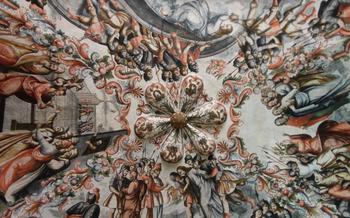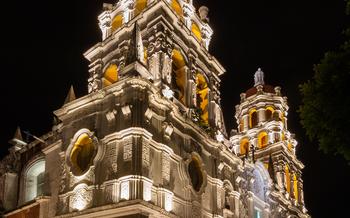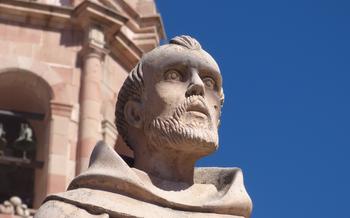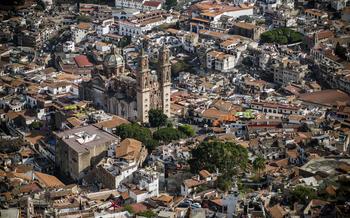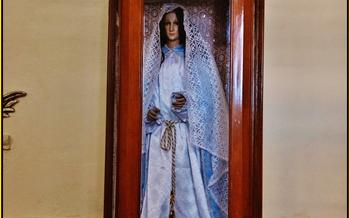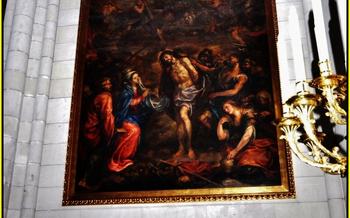
Parroquia de San José
- Architectural Marvel
- Religious Significance
- Cultural Landmark
- Must-See Interior
- Local Traditions
- Pilgrimage Site
- Dress Code
- Photography and Videography
- Accessibility
- Guided Tours:
- Insider Tip: For a truly memorable experience, visit the Parroquia de San José during one of the many religious festivals or celebrations held throughout the year. These festivals, such as the Feast of San José in March or the Day of the Dead in November, offer a unique glimpse into Puebla's rich cultural and religious heritage. Immerse yourself in the vibrant atmosphere, witness traditional dances and music, and join in the festivities with the local community. It's an opportunity to experience the church's spiritual and cultural significance firsthand and create lasting memories of your visit to Puebla.
Architectural Marvel
The Parroquia de San José is a stunning architectural masterpiece that showcases a blend of Baroque and Neoclassical styles. Its façade is adorned with intricate carvings, sculptures, and reliefs that depict religious scenes and figures. The church's interior is equally impressive, with vaulted ceilings, ornate altars, and a magnificent dome that allows natural light to flood the space. The main altar is a work of art in itself, featuring intricate carvings, sculptures, and paintings that depict the life of Saint Joseph, the church's patron saint. The church's overall design reflects the artistic and cultural influences of the time period, making it a testament to the skill and craftsmanship of the architects and artisans who created it. One unique feature of the Parroquia de San José is its two bell towers, which offer panoramic views of Puebla. Visitors can climb the towers to experience the breathtaking vistas of the city's historic center, the surrounding mountains, and the iconic Popocatépetl volcano.
Religious Significance
The Parroquia de San José is a devout center of Catholic worship in Puebla, revered by locals for its spiritual and religious significance. The church is dedicated to San José, the patron saint of the city, who holds a special place in the hearts of the local community. San José, also known as Saint Joseph, is recognized as the earthly father of Jesus Christ and is revered for his virtues of humility, justice, and obedience. Throughout the year, the church hosts numerous religious ceremonies, festivals, and processions honoring San José and other saints. These events are attended by devout Catholics from Puebla and beyond, creating a vibrant and spiritual atmosphere. The Parroquia de San José serves as a sacred space where locals can deepen their faith, seek solace, and connect with their religious community.
Cultural Landmark
The Parroquia de San José is not just a religious site; it is also a symbol of Puebla's cultural identity. The church has played a significant role in shaping the city's cultural landscape and traditions. Throughout history, the church has been featured in local art, literature, and music, reflecting its deep connection to the city's cultural heritage. In recognition of its outstanding cultural significance, the Parroquia de San José has been designated as a UNESCO World Heritage Site, further solidifying its status as a cultural landmark of national and international importance.
Must-See Interior
The interior of the Parroquia de San José is a testament to the grandeur and artistry of Baroque and Neoclassical architecture. The intricate details, vibrant colors, and symbolic elements create a breathtaking and awe-inspiring atmosphere. As you step inside, your eyes will be drawn to the main altar, a masterpiece of carved wood and gilded ornamentation. The intricate carvings depict scenes from the life of San José and the Holy Family, while the gold leaf adds a touch of opulence and reverence.
The choir loft, located above the main entrance, is another highlight of the church's interior. Supported by elegant columns and arches, the loft features a beautifully carved wooden railing and a set of ornate choir stalls. The stalls are decorated with intricate carvings and inlaid with mother-of-pearl, showcasing the exceptional craftsmanship of the artisans who created them.
The stained glass windows, depicting various biblical scenes and saints, fill the interior with colorful light. The vibrant hues and intricate designs create a kaleidoscope of colors that dance across the walls and floor, adding to the ethereal atmosphere of the church.
Take your time to explore the side altars, each dedicated to a different saint or devotion. Adorned with sculptures, paintings, and intricate carvings, these altars are works of art in their own right. The walls are adorned with frescoes and murals depicting biblical scenes and the life of San José, adding to the rich visual narrative of the church's interior.
The overall atmosphere of the Parroquia de San José's interior is one of awe, reverence, and beauty. The harmonious blend of architectural styles, intricate details, and symbolic elements creates a sacred space that invites visitors to contemplate and connect with the divine.
Local Traditions
The Parroquia de San José is deeply intertwined with the local traditions and customs of Puebla. During the annual Feria de Puebla, which takes place in April or May, the church becomes the focal point of religious processions and celebrations. The faithful gather to honor the patron saint, San José, and participate in colorful parades that wind through the streets of the historic center.
Another significant tradition is the "Lavatorio de los Pies," which takes place on Maundy Thursday during Holy Week. In this symbolic ritual, the bishop washes the feet of twelve individuals, representing Jesus's washing of his disciples' feet. The ceremony is a moving display of humility and service and attracts many visitors who come to witness this unique tradition.
Throughout the year, the church also hosts various religious festivals and events. These celebrations often include traditional music, dance, and food, creating a vibrant and festive atmosphere in the plaza. Locals and visitors alike come together to celebrate their shared faith and cultural heritage, making the Parroquia de San José a living testament to the enduring traditions of Puebla.
Pilgrimage Site
The Parroquia de San José holds a significant place as a pilgrimage site for Catholics in Mexico. Pilgrims from across the country and beyond flock to the church to venerate San José, the patron saint of the church and a beloved figure in Catholic tradition. Many pilgrims believe that San José possesses the power to intercede on their behalf and grant their prayers.
Pilgrims often undertake specific rituals and practices during their visits to the church. They may light candles, pray at the altar, and touch or kiss a relic of San José. Some pilgrims even choose to walk barefoot to the church as a sign of devotion and penance.
The pilgrimage experience at the Parroquia de San José is deeply spiritual and emotional for many visitors. Pilgrims often express a sense of peace, hope, and renewal after their visit. The church provides a sacred space for pilgrims to connect with their faith, seek divine intervention, and find solace and comfort.
Dress Code
As a sacred place of worship, the Parroquia de San José requires visitors to dress respectfully. This means avoiding shorts, tank tops, and any clothing that is revealing or overly casual. Shoulders and knees should be covered, and visitors should opt for modest and conservative attire. The dress code is in place to maintain the sanctity of the church and to show respect for the religious traditions and beliefs of the local community. By adhering to the dress code, visitors can demonstrate their respect and contribute to the peaceful and reverent atmosphere of the Parroquia de San José.
Photography and Videography
When visiting the Parroquia de San José, it is important to be respectful of the sacred nature of the site. Photography and videography are generally permitted inside the church, but visitors are asked to be mindful of other visitors and worshippers. It is essential to avoid using flash photography or making excessive noise while taking photos or videos. Additionally, certain areas of the church, such as the altar, may be restricted from photography or videography. Visitors are advised to seek permission from the church authorities before taking any photos or videos in these areas. By following these guidelines, visitors can help preserve the sanctity of the Parroquia de San José while capturing their memories of this awe-inspiring landmark.
Accessibility
The Parroquia de San José is committed to providing an accessible and welcoming environment for visitors of all abilities. The church features several accessibility features to ensure that everyone can enjoy its beauty and spiritual significance. Wheelchair-accessible entrances are available at the front and side of the church, and ramps are provided to facilitate movement throughout the interior. Designated seating areas for visitors with disabilities are located near the front of the church, offering a clear view of the altar and the proceedings. Upon request, the parish office can arrange for special assistance, such as providing wheelchairs or guiding visitors through the church. With these thoughtful provisions, the Parroquia de San José strives to make its sacred space accessible and inclusive for all.
Guided Tours:
Guided tours of the Parroquia de San José are available for visitors who wish to delve deeper into the history, architecture, and religious significance of this magnificent church. These tours are led by knowledgeable guides who provide insights and explanations that bring the church to life. General history tours offer an overview of the church's construction, architectural style, and historical events associated with it. Architectural tours focus on the unique design features, symbolism, and artistic influences that make the Parroquia de San José stand out. Religious tours explore the church's role as a center of Catholic worship, the significance of its patron saint, San José, and the various religious traditions and ceremonies that take place within its walls.
The cost of guided tours varies depending on the type of tour and the group size. Reservations can be made in advance through the church office or through local tour operators. Taking a guided tour is an excellent way to gain a deeper understanding and appreciation of the Parroquia de San José, its cultural significance, and its enduring legacy as a symbol of Puebla's faith and heritage.
